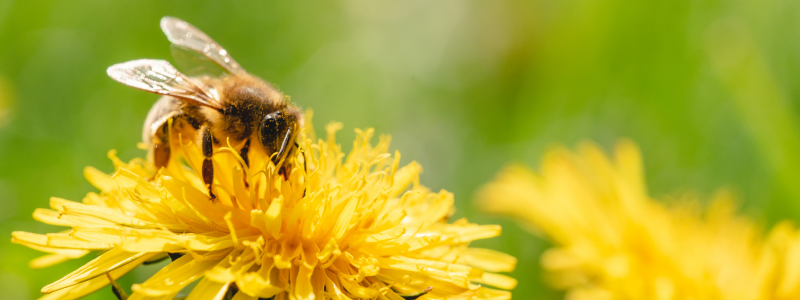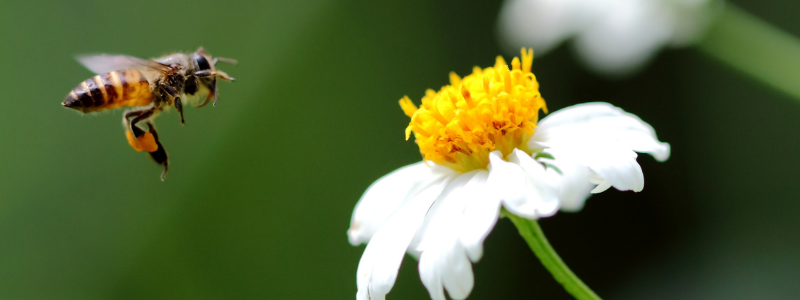We, as humans, can learn a lot from the habits of bees! The more we learn about honey bees, the more we notice florists have very similar busy lifestyles, having to juggle their personal lives, along with every aspect of their businesses. Just like bees, florists work hard around the clock, are creative, bring beauty and joy to people's lives, and play vital roles in our ecosystem.
Like Florists, Bees Pollinate the World with Beauty:

Bees are incredibly industrious creatures, and they can teach us a lot about working habits. Here are just a few things we can learn from the work habits of bees:
- Organization: Bees have a very organized society, with each bee playing a specific role.
- Efficiency: They use their time and resources wisely and always seem to be working towards a goal.
- Cooperation: Bees are known for working together to achieve their goals. They communicate with each other and help each other out.
- Persistency: Bees don't give up easily, even when a challenge faces them.
- Adaptability: Bees can live in a variety of habitats and can adjust to changes in their environment.
Overall, bees are excellent role models for us. They can teach us a lot about effective habits and how to live a successful and productive life.
Breaking the Busyness Trap:

Even though we can learn a lot from the work ethics of honey bees, at the end of the day, humans are not built to work 24/7. Some of us feel like we are working as much as a bee would and are caught in what is called the "busyness trap." Sometimes we don't even notice we are caught in this trap and need to be mindful of our health and take time to rest and recharge.
Here are three ways you can start to break free of the busyness trap:
- Set up times to turn off electronics. That means no checking your phone, work emails, or texts for at least an hour daily. Maybe it's when you first wake up or right before you go to sleep.
- Reduce your busy behaviors. It's okay to say "no" to work or personal tasks when you are feeling overwhelmed. If you have the ability to delegate tasks, do it! Take breaks and set boundaries - It's so important.
- Use Details Flowers Software to help plan your events. Details is like having an operations manager, marketing guru, and financial officer all rolled into one. Our mission is for florists to get time back while streamlining processes and growing their businesses simultaneously!
Fun Facts About Honey Bees:

Here are some truly fascinating facts about honey bees-
- There are three kinds of bees in a hive: Queen, Worker, and Drone (Male).
- A beehive in summer can hold around 50,000-80,000 bees.
- A queen will lay between 1,500-2,000 eggs per day.
- Losing its stinger will cause a bee to die (worker bees only.) Males don’t have stingers.
- Bees have been here for about 30 million years! Honey was found in the tombs in Egypt, and it was still edible!
- Honey comes in different colors and flavors. The flower from which the nectar was gathered determines the honey's flavor and color.
- Nectar is a sweet watery substance that the bees gather. After they process the nectar in their stomach, they regurgitate it into the honeycomb cells. Then they fan with their wings to remove excess moisture. The final result is honey.
- A bee must collect nectar from about 2 million flowers to make 1 pound of honey. It requires 556 worker bees to gather a pound of honey. Bees fly more than once around the world to gather a pound of honey.
- A honeybee can fly 24 km in an hour at a speed of 15 mph. Its wings beat 200 times per second or 12,000 beats per minute.
- Bees are important because they pollinate approximately 130 agricultural crops in the US.
- As pollinators, honey bees help flowers produce fruits and seeds. Female worker bees fly from plant to plant in search of nectar and pollen to feed their colony. On their way, the tiny hairs all over their body help pick up pollen from one flower and brush it onto another, thus aiding the plant’s reproduction process. As a result, farmers can produce larger, better-quality crops. Every year, honey bees contribute an estimated $20 billion to the United States' agriculture industry. Crops such as blueberries, cherries, and almonds rely heavily on honey bees—without their work as pollinators, these foods would become much rarer or even disappear altogether.
- The average life of a honey bee during the working season is about three to six weeks. There are five products that come from the hive: Honey, beeswax, pollen, propolis, and royal jelly.
Start your free 7-day trial of Details here OR schedule a 15-Minute Introductory Call with one of our Team Members to learn more about Details!



